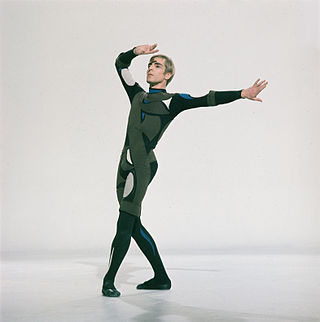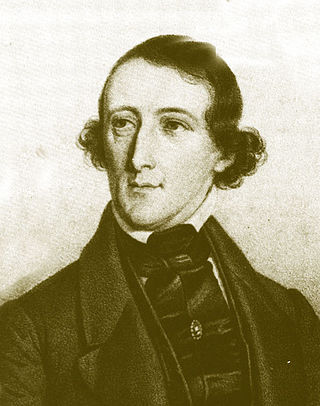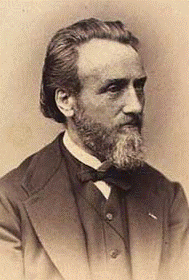
August Bournonville was a Danish ballet master and choreographer. He was the son of Antoine Bournonville, a dancer and choreographer trained under the French choreographer, Jean Georges Noverre, and the nephew of Julie Alix de la Fay, née Bournonville, of the Royal Swedish Ballet.

Erik Belton Evers Bruhn was a Danish ballet dancer, choreographer, artistic director, actor, and author.

In ballet, a pas de deux is a dance duet in which two dancers, typically a male and a female, perform ballet steps together. The pas de deux is characteristic of classical ballet and can be found in many well-known ballets, including Sleeping Beauty, Swan Lake, and Giselle. It is most often performed by a male and a female though there are exceptions, such as in the film White Nights, in which a pas de deux is performed by Mikhail Baryshnikov and Gregory Hines.
Ib Andersen is a Danish ballet dancer and choreographer. He was principal dancer for the Royal Danish Ballet 1975-1980, for the New York City Ballet 1980-1990, freelancing ballet master 1990-2000 and artistic director of Ballet Arizona 2000-2024.

Les Ballets Trockadero de Monte Carlo is an all-male drag ballet troupe that parodies the conventions of romantic and classical ballet. The company's current artistic director is Tory Dobrin.

Napoli, or The Fisherman and His Bride is a ballet created in 1842 for Denmark's Royal Ballet by Danish choreographer and ballet master August Bournonville. It tells the story of Teresina, a young Italian girl who falls in love with Gennaro, a fisherman, and culminates in the marriage of the lovers.
Dame Merle Park, is a British ballet dancer and teacher, now retired. As a prima ballerina with the Royal Ballet during the 1960s and 1970s, she was known for "brilliance of execution and virtuoso technique" as well as for her ebullience and charm. Also admired for her dramatic abilities, she was praised as an actress who "textured her vivacity with emotional details."
Tarantella is a ballet choreographed by George Balanchine to Grande Tarantelle by Louis Moreau Gottschalk, arranged by Hershy Kay. The ballet premiered on January 7, 1964, at the New York City Center, performed by New York City Ballet's Patricia McBride and Edward Villella.

Le Conservatoire, or A Marriage by Advertisement is a two-act vaudeville ballet created by the Danish choreographer and ballet master August Bournonville in 1849 for the Royal Danish Ballet. The ballet's setting is a dance studio at the Conservatoire de Paris. Bournonville studied at the Paris Conservatoire in the 1820s with the renowned dancer Auguste Vestris. The ballet launched the career of prima ballerina Juliette Price. A divertissement within the larger work called "The Dancing School" permitted Bournonville to display the basics of his style and raise them to the level of enduring art.

The Kermesse in Bruges, or The Three Gifts is a burlesque ballet in three acts created by the Danish ballet master and choreographer August Bournonville to music by Holger Simon Paulli, first performed by the Royal Danish Ballet on 4 April 1851. The Danish title is Kermessen i Brügge eller De tre Gaver. The ballet tells the story of three brothers who receive magic gifts from an alchemist.
Thomas Lund is the head master of The Royal Danish School of Ballet in Copenhagen. Lund admitted to The Royal Danish School of Ballet in 1986 aged 11. He became apprentice in 1991, member of the corps de ballet of The Royal Danish Ballet in 1993, soloist in 1996 and was appointed principal dancer in 2000. In September 2012 Lund retired as a Principal Dancer to become the head master of The Royal Danish School of Ballet He held that position until June 2022.

Edvard Mads Ebbe Helsted was a Danish composer. He is the brother of composer Carl Helsted.
Frank Andersen is a former Danish ballet dancer who was twice artistic director of the Royal Danish Ballet. He has been an influential supporter of the Danish choreographer August Bournonville.
Manuel Legris is a French ballet dancer. He is an étoile with the Paris Opera Ballet for 23 years. On September 1, 2010, he became the director of the Vienna State Ballet. In December 2020, he was appointed artistic director of the La Scala Theatre Ballet.
Alban Lendorf is a Danish ballet dancer, choreographer, and actor, who was a principal with the Royal Danish Ballet and the American Ballet Theatre. He also was a guest artist with the English National Ballet and the Stanislavski Ballet.

Dinna Bjørn is a Danish ballet dancer and choreographer. She has specialized dancing and directing the ballets of August Bournonville. Bjørn has also created five Hans Christian Andersen ballets for the Pantomime Theatre in Copenhagen's Tivoli.

Elise Juliette Christiane Price, usually known as Juliette Price, (1831–1906) was a Danish ballet dancer. She studied under August Bournonville, becoming his favourite dancer.
Toni Lander née Pihl Petersen (1931–1985) was a Danish ballerina who specialized in the ballets of August Bournonville. After becoming a solo dancer with the Royal Danish Ballet in 1950, she was a guest dancer with the Original Ballet Russe in 1951. She was then engaged by the Paris Opera Ballet until 1954. Lander also appeared with the London Festival Ballet in the late 1950s and with the American Ballet Theatre in the 1960s. After a few years back in Denmark in the early 1970s, in 1976 she joined the Ballet West in Salt Lake City. After a short illness, she died there of cancer in May 1985.
Heidi Ryom Kristensen was a Danish ballerina and educator for the Royal Danish Ballet. She began dancing at the Royal Danish Ballet school and became an in 1972 before being made a corps dancer at the Royal Danish Ballet two years later. In 1982, Ryom was appointed principal solo dancer at the Royal Danish Theatre before retiring from her position as a solo dancer in 1997 and became a character dancer and educator. She was appointed Knight of the Order of the Dannebrog in 1988 and was promoted to Knight First Class of the Order of the Dannebrog eight years later.










